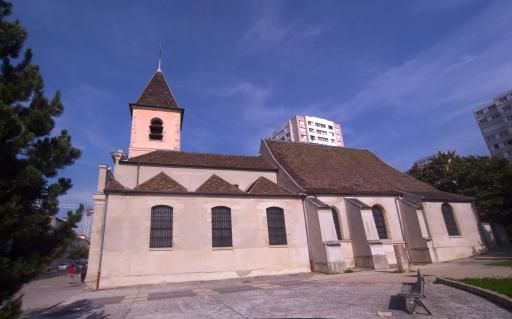
The founding of the old Bagnolet chapel is thought to have coincided with the foundation of the Parisian church erected under the same patronage in 1235. It became a parish in the late 13th century. The current building was constructed in two stages. In its earliest form, the church comprises a central nave flanked by aisles, with a low-profile chapel at the south-west end of the south aisle. The initials and coats of arms of Henri II and Diane de Poitiers can be found on the eastern side of the building, dating its construction to between 1547 and 1559. Between the 16th-century bays, buttresses - massive, projecting masonry reinforcements erected on the exterior face of a vaulted building to contain the effects of a load or the thrust of arches and vaults - were built. The statue of Sainte-Anne dates from the 15th century.
Plans for the construction of the more recent section are attested as early as 1711. The date 1750, inscribed on the ceiling of the third bay, indicates the approximate date of construction of the three western bays added in the 18th century, this time without buttresses. The main façade and bell tower were built in the second half of the 18th century. The organ case was built at the end of the 18th century. The 1808-1812 cadastral map shows a 350-square-meter plot of land to the south-east of the chevet, occupied by the cemetery. Burials have been observed in the cross-section of a test pit, four meters from the chevet.
The church of Saint-Leu-et-Saint-Gilles was listed as a Monument Historique on November 29, 1977.
The Saint-Leu-Saint-Gilles church in Bagnolet almost disappeared in the 1970s, as the parish priest at the time had no intention of restoring it. It was Jacqueline Chonavel, the town's PC mayor, who took the decision to launch the restoration of the building. Despite state subsidies for heritage preservation, the restoration was both costly and time-consuming. It was completed in 2000, when the church was reopened for worship. Then, from 2003 onwards, under the impetus of two local councillors, Michel Levacher and Marie-Victorine Nyangoh-Timoh, the municipality, again with the help of subsidies, undertook to restore fourteen stained glass windows, including one for the church.These included three new creations, which had to be completely recreated due to deterioration, and ten large paintings. It took no less than ten years to restore the interior decor. In May 2013, the last two of the ten paintings, works measuring three by two meters, saved by the heritage restorers, were reinstalled on the church walls. The other eight paintings, including a luminous Mater dolorosa and a copy of a work from the Prado (the Madrid museum) had previously been hung.
A wood gilder, Jean-Pierre Galopin, took care of the framing, which was all redone. The final touches to the framing of these last two paintings were made on site, during the hanging at the entrance to the church. As for the painting, Martine Martin has done an excellent job. Some of the torn canvases had to be sewn and mended first," she explains. As a result, whole swathes of paint disappeared. Martine Martin worked from black-and-white photos, recovering the original shades from the traces of color still present on the paintings. " The first difficulty was to remove the encrusted grime from all the works without touching the paint," she explains. Thanks to these craftsmen - artists, you might say - the Saint-Leu-Saint-Gilles church has been restored to its former glory.
Saint Gilles the Hermit was born in Athens and lived in Provence in the 7th century. He was a legendary gyrovague monk from Merovingian Occitania (a monk who lived alone, wandering from monastery to monastery, without being a member of any order).Gilles l'Ermite was sanctified by the Benedictines in the 8th century. His story has often been confused with his legend, and his tomb, located on the route to Santiago de Compostela, was an extremely popular place of pilgrimage in the Middle Ages. Patron saint of the infirm, beggars and blacksmiths, he was venerated as one of the fourteen auxiliary saints. He is referred to as an "auxiliator" saint, in the sense of intercessor, in cases of epilepsy, madness, sterility and demonic possession. More prosaically, he helps people move house and move towards emancipation or deliverance! His name has been given to many religious buildings and places.
Saint Loup or Leu was born of an illustrious family in Orléans around 573. His reputation was such that he was elected bishop of Sens. While most of the people of Sénonais were delighted with this new bishop, endowed with every virtue, he also aroused jealousy. His detractors accused him of being too fond of Verosia, the daughter of his predecessor, but Leu refused to defend himself. Legend has it that he managed to repel enemy troops attempting to invade the Burgundian kingdom with his prayers alone. Victim of slander, he was exiled by the king to Neustria, where he settled. Leu took advantage of this opportunity to convert the local population and baptize many people. But his flock missed the bishop of Sens, and asked Clotaire to call him back from exile. The king agreed, and Leu returned to Sens. He was more virtuous than ever and performed numerous miracles. He died in 623, on September 1, the date on which he is honored today. Miracles are still attributed to him at his tomb.
In the Paris region, the names of Gilles l'Ermite and Loup de Sens, or Saint Leu, are often associated for the sole reason that the feasts of these two saints fall on the same day, September 1. The two men are also the subject of a saying:
A la Saint-Loup, la lampe au clou
If it rains on Saint-Gilles, it lasts until Saint-Michel
Photo credit: By Poulpy (Own work)[CC-BY-SA-3.0], via Wikimedia Commons